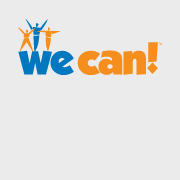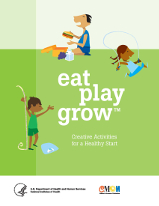Family Meal
Early Childhood Health Lesson
Objective:
Learn the importance of working together to create a healthy, affordable, and easy to make meal.
We Can! Messages
Increase availability and accessibility of healthy foods in the home.
Control portion sizes.
Limit intake of high-fat and high-calorie foods that are low in nutrients.
Limit the availability and accessibility of sugar-sweetened beverages.
Limit the availability and accessibility of high-fat, high-calorie/low nutrient foods in the home.
National Pre-K–2nd Grade Health Performance Standards
Identify how the family influences personal health practices and behaviors.
Adult Message
Positive family eating habits can influence a child’s cognitive, social, emotional, and physical well-being.
Developing Preschool Readiness Skills
Developing listening skills, learning to follow directions, and building language through social and group interaction.
Program Content
Themed lesson plans incorporating art, literacy, movement and music support a
multi-disciplinary approach to teaching young children and adults.
Program Length: 70 minutes
Introduction/Discussion
Materials: Name stickers, markers
Welcome families with name stickers and “hello” song. Ask families how often they eat
together. Lead a discussion around the challenges, benefits, and the importance of sharing
family meals. Encourage and provide strategies for adults to engage children in the preparation
and responsibilities surrounding family meals. Use this as an opportunity to review and
summarize the health messages we have covered so far (foods with multiple colors and textures,
inclusion of fruits and vegetables in every meal, calcium-rich foods and beverages, portion plate
template, water consumption, and washing hands). Allow time for families to share their own
mealtime challenges and strategies.
Visual References: Pictures of families from all over the world preparing meals and eating
together.
Key Teaching Messages
- Social settings, especially family settings, have a powerful influence on child’s behaviors and habits.
- Home cooking can be more nutritious than fast food and take-out options—and cheaper!
- Family meals are beneficial for a child’s emotional, physical, and mental development.
Art Activity: Personalized Placemat and Personalized Chef’s Apron
Children and adults will each create their own unique placemat that will serve as a creative and positive reinforcement for sharing family meals. Children will create their own chef’s apron.
Materials: For Placemat: Oak tag, pictures of healthy foods, alphabet letters, glue sticks, markers, and laminator (or plastic sleeves). Recycled health and fitness magazines. For Chef’s Apron: apron, colored markers, or fabric markers.
Set-up: Placemat Activity: Place two pieces of tape to each end of the oak tag. Place one piece of oak tag paper at each seat. Place one glue stick at each seat. You might have to demonstrate how to remove the top of the glue stick and how to move it up and down. Separate the pictures and alphabet letters on the table into separate piles. Make sure that all children at the table can reach the materials. Hand out child-safe scissors to the grown-ups at the table. Adults can help the children cut images out of the magazines. When the children are finished with their placemats, remove the tape from the oak tag. Use a marker to write the child’s name on the back of the placemat.
Option 1: Have the laminator set up at a different table. Make sure the laminator is on and is hot. NOTE: DON’T LET THE CHILDREN HELP WITH LAMINATING. THE LAMINATOR GETS EXTREMELY HOT! They can watch. Place the oak tag paper placemat in a clear laminator sheet, then into the cardboard laminator protector and feed it through the laminator. When it comes out, check to make sure the placemat has been properly laminated. If not, feed it through the laminator again. When the placemat is completely laminated, place on the table to cool off.
Option 2: Collect all placemats and laminate off-site and return to families.
Option 3: Use plastic jacket sleeves.
Set-up: Apron Activity: Provide each child with an apron and markers.
Clean-up: Give children a 5 minute warning. Always let children know that you will be transitioning and ending the project soon. After the warning, sing a clean-up song to focus children and encourage participation in the clean-up process. One example: “Clean up, clean up, one, two, three. I’ll help you and you help me. Clean up, clean up, one, two, three. I’ll help you and you help me.”
Cooking Demonstration
Chef or cooking expert will lead a hands-on, creative cooking demonstration that engages both parent and child in creating a healthy balanced meal. Check out these recipes for ideas. Keep the Beat: Deliciously Healthy Eating website: http://healthyeating.nhlbi.nih.gov
Encourage children to wash hands with soap and warm water before eating snack. Hand
Washing Strategy: Wash hands for 20 seconds to fight off all germs and then rinse well under
running water. Sing the ABC Song while you wash.
Physical Activity: Movement/Music
Weekly Structure: Warm-up, Active Play Time, Movement/Music (song/activity), Cool-down. Children should do at least 60 minutes (1 hour) or more of physical activity each day.
Warm-up:
Marching Movement Song
We’re marching, marching, marching
We’re marching in a circle
We’re marching, marching, marching until it’s time to stop!
We’re jumping, jumping, jumping
We’re jumping in a circle,
We’re jumping, jumping, jumping until it’s time to stop!
(add hopping, stomping, running, tiptoeing, etc.)
In and Out Circle Song
Let’s go in and in and in
And out and out and out
And in and in and in and in
And out and out and out!
Active Play Time:
Do 5 or 10 minutes of each exercise
- Playing Tag
- Hopscotch
- Jumping Jacks
- Jumping (one foot, together then apart, front to back)
Movement/Music:
Songs – Row, Row, Row Your Boat and Grand Old Duke of York
Roller Coaster – Have the adult sit with their legs straight out. Have the child sit in between the adult’s legs. Now, pretend you are on a roller coaster. As the roller coaster goes up the parent and child lean back. As the roller coaster goes down the pair lean forward and scream. Then lean left and right as the roller coaster turns.
Train – Have the adult sit with their legs straight out. Have the child sit in between the adult’s legs. As the train takes off the pair moves their arms like the train wheels rolling. Make noises of the train and hear the whistle blow!
Cool-down:
It is important for the body to cool down gradually.
- Breathing–Place hands on belly or lower back. Inhale and fill the lungs. Feel the abdomen and ribs inflate. Exhale and empty the lungs. Feel the chest and abdomen relax.
- Yoga Moves
- Downward Dog–Have the children make a bridge with their bodies. From here you can kick one leg up at a time and start to stretch body long.
- Tree Pose–Have the children balance on one leg, bending their other leg at a 90 degree angle, stretching their hands above their heads.
- The Horse–Stand in place for 30 seconds with a wide stance and knees bent (like a halfway down squat position).
Group Storytime
Don’t Let the Peas Touch by Deborah Blumenthal
Gregory, the Terrible Eater by Mitchell Sharmat
The Berenstain Bears Forget Their Manners by Stan Berenstain and Jan Berenstain
Review Family Handout
Goal: Have two or more family-style meals together this week.
Facts of the Week: Children are more likely to try new foods when they are eating with their family.
At-Home Strategies:
- Have all family members contribute to the meal so that responsibilities are shared.
- Introduce children to new healthy foods and act as a role model for healthy eating.
- For conversation, share “best” and “worst” moments of the day.
- Make eating together a routine and make it a family commitment.
- Planning meals and using a shopping list helps save money and time!
Lesson Visuals
- MyPlate
Family Meal
Early Childhood Health Lesson
Food Servings
Vegetables 1 light bulb
Fruits 1 light bulb
Grains 1 Baseball
Protein 1 Deck of Cards
Family Health Handout
Family Meal
Benefits of Family Meals:
- Family meals influence children’s eating habits.
- Families bond during meal time.
- Parents model good eating habits.
- Children spend less time in front of television.
- Children practice social and conversational skills.
Farmers Market or Green Cart Shopping List
Make a healthy salad to go with your family meal. Save money by visiting your local market or farmer’s market and pick up some carrots, cucumbers, and tomatoes.
Family Goal
Goal: Have two family-style meals together this week. Family-style meals include dividing the responsibilities between shopping, cooking, setting the table, and clearing and washing the dishes.
First Meal
Shopping
Cooking
Table Setting
Table Clearing
Washing Dishes
Second Meal
Shopping
Cooking
Table Setting
Table Clearing
Washing Dishes
Fact of the Week
Children are more likely to try new foods when they are eating with their family.
Saving Money Tips
Buy fruits and vegetables that are in season, and remember frozen or canned fruits and vegetables are healthy options, too! Planning meals, creating shopping lists, and clipping coupons can save money and time!
Surprising Fact
Family activities influence a child’s school success more than parents' income or education.
Strategy
Introduce children to new healthy foods and act as a role model for healthy eating. Use the MyPlate concept to talk to your kids about the dietary messages. Link to: www.choosemyplate.gov
At-Home Tools
Dinner Books
The Berenstain Bears Forget Their Manners by Stan Berenstain and Jan Berenstain
Don’t Let the Peas Touch by Deborah Blumenthal
Gregory, the Terrible Eater by Mitchell Sharmat
New Meal Words to Use
- Family
- Sharing
- Teamwork
- Responsibility
- Conversation
Did you know…
Young children can develop a sense of pride and responsibility as they contribute to the family meal preparations.
Fun Activities
Where Do I Sit at the Table?
Children can create name or picture cards for each
family member and then assign seats at the dinner
table. This will allow them to be creative while also
learning their letters, shapes, and colors
Shopping Lists
Give children the responsibility of helping you
choose the fruits and vegetables for the week. Help
them practice counting skills and color recognition!
Dinner Recipes
Healthy meals do not have to cost a lot of money. Try these healthy, budget-friendly dinner recipes with your family.
Mini Pizzas
Using whole wheat pita bread, spread
low-fat mozzarella cheese, then add fresh
peppers, onions, or even pineapple. Bake in
oven until cheese is melted.
Chef Salad
Start with fresh lettuce. Have children tear
leaves, then sort and toss tomatoes, sweet
peppers, carrots, hard-boiled eggs, ham,
cheese, cucumbers, and celery. Serve dressing
made of 1/2 cup olive oil, 1/2 cup balsamic
vinegar, and teaspoon of honey.
| Back to Table of Contents | Back to Top |
NIH Publication No. 13-7818
April 2013











